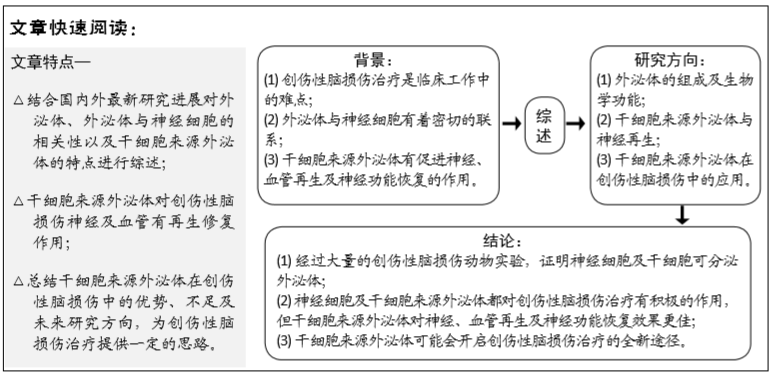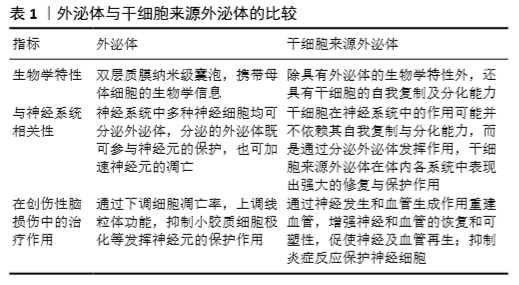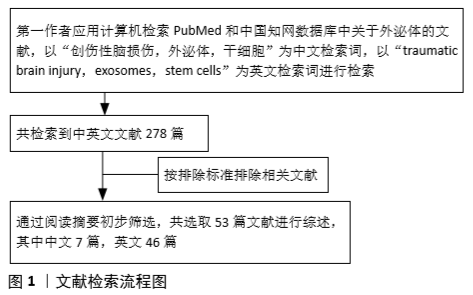[1] FEIGIN VL, THEADOM A, BARKER-COLLO S, et al. Incidence of traumatic brain injury in New Zealand: a population-based study. Lancet Neurol. 2013;12(1): 53-64.
[2] MAAS AIR, MENON DK, ADELSON PD, et al. Traumatic brain injury: integrated approaches to improve prevention, clinical care, and research. Lancet Neurol. 2017;16(12):987-1048.
[3] JIANG JY, GAO GY, FENG JF, et al. Traumatic brain injury in China. Lancet Neurol. 2019;18(3):286-295.
[4] 朱佳敏,刘玉梅,张自强,等.干细胞源外泌体修复神经损伤的研究现状[J].中国临床药理学杂志,2019,35(13):1413-1416.
[5] 徐耀禄,刘玉梅,张自强,等.干细胞源外泌体对组织缺血再灌注损伤治疗的研究进展[J].中国临床药理学杂志,2019,35(18):2171-2174.
[6] 关梦珊,丘玉平,董凤英,等.干细胞源性外泌体在心血管疾病中的研究进展[J].实用医学杂志,2018,34(18):3143-3145.
[7] 张恩国,陈尚雅,杨叶,等.干细胞源外泌体应用于再生医学的研究进展[J].中国组织工程研究,2018,22(5):801-806.
[8] ZHANG Y, CHOPP M, ZHANG ZG, et al. Systemic administration of cell-free exosomes generated by human bone marrow derived mesenchymal stem cells cultured under 2D and 3D conditions improves functional recovery in rats after traumatic brain injury. Neurochem Int. 2017;111:69-81.
[9] THÉRY C, ZITVOGEL L, AMIGORENA S. Exosomes: composition, biogenesis and function. Nat Rev Immunol. 2002;2(8):569-579.
[10] KOUREMBANAS S. Exosomes: vehicles of intercellular signaling, biomarkers, and vectors of cell therapy. Annu Rev Physiol. 2015;77: 13-27.
[11] EL ANDALOUSSI S, MÄGER I, BREAKEFIELD XO, et al. Extracellular vesicles: biology and emerging therapeutic opportunities. Nat Rev Drug Discov. 2013;12(5): 347-357.
[12] KARNATI HK, GARCIA JH, TWEEDIE D, et al. Neuronal Enriched Extracellular Vesicle Proteins as Biomarkers for Traumatic Brain Injury. J Neurotrauma. 2019; 36(7):975-987.
[13] WIECKOWSKI EU, VISUS C, SZAJNIK M, et al. Tumor-derived microvesicles promote regulatory T cell expansion and induce apoptosis in tumor-reactive activated CD8+ T lymphocytes. J Immunol. 2009;183(6):3720-3730.
[14] LEONE DA, REES AJ, KAIN R. Dendritic cells and routing cargo into exosomes. Immunol Cell Biol. 2018 May 24. doi: 10.1111/imcb.12170. [Epub ahead of print]
[15] GOETZL EJ, SCHWARTZ JB, ABNER EL, et al. High complement levels in astrocyte-derived exosomes of Alzheimer disease. Ann Neurol. 2018;83(3):544-552.
[16] STREET JM, KORITZINSKY EH, GLISPIE DM, et al. Urine Exosomes: An Emerging Trove of Biomarkers. Adv Clin Chem. 2017;78:103-122.
[17] DE LA TORRE GOMEZ C, GOREHAM RV, BECH SERRA JJ, et al. “Exosomics”-A Review of Biophysics, Biology and Biochemistry of Exosomes With a Focus on Human Breast Milk. Front Genet. 2018;9: 92.
[18] RIANCHO J, VÁZQUEZ-HIGUERA JL, POZUETA A, et al. MicroRNA Profile in Patients with Alzheimer’s Disease: Analysis of miR-9-5p and miR-598 in Raw and Exosome Enriched Cerebrospinal Fluid Samples. J Alzheimers Dis. 2017;57(2):483-491.
[19] GUITART K, LOERS G, BUCK F, et al. Improvement of neuronal cell survival by astrocyte-derived exosomes under hypoxic and ischemic conditions depends on prion protein. Glia. 2016;64(6):896-910.
[20] FRÖHLICH D, KUO WP, FRÜHBEIS C, et al. Multifaceted effects of oligodendroglial exosomes on neurons: impact on neuronal firing rate, signal transduction and gene regulation. Philos Trans R Soc Lond B Biol Sci. 2014;369(1652). pii: 20130510.
[21] ASAI H, IKEZU S, TSUNODA S, et al. Depletion of microglia and inhibition of exosome synthesis halt tau propagation. Nat Neurosci. 2015;18(11):1584-1593.
[22] BUDNIK V, RUIZ-CAÑADA C, WENDLER F. Extracellular vesicles round off communication in the nervous system. Nat Rev Neurosci. 2016;17(3):160-172.
[23] OHMICHI T, MITSUHASHI M, TATEBE H, et al. Quantification of brain-derived extracellular vesicles in plasma as a biomarker to diagnose Parkinson’s and related diseases. Parkinsonism Relat Disord. 2019;61:82-87.
[24] PULLIAM L, SUN B, MUSTAPIC M, et al. Plasma neuronal exosomes serve as biomarkers of cognitive impairment in HIV infection and Alzheimer’s disease. J Neurovirol. 2019;25(5):702-709.
[25] FAURÉ J, LACHENAL G, COURT M, et al. Exosomes are released by cultured cortical neurones. Mol Cell Neurosci. 2006;31(4):642-648.
[26] FRÜHBEIS C, FRÖHLICH D, KUO WP, et al. Neurotransmitter-triggered transfer of exosomes mediates oligodendrocyte-neuron communication. PLoS Biol. 2013;11(7): e1001604.
[27] LOPEZ-VERRILLI MA, PICOU F, COURT FA. Schwann cell-derived exosomes enhance axonal regeneration in the peripheral nervous system. Glia. 2013;61(11): 1795-1806.
[28] BIANCO F, PRAVETTONI E, COLOMBO A, et al. Astrocyte-derived ATP induces vesicle shedding and IL-1 beta release from microglia. J Immunol. 2005;174(11): 7268-7277.
[29] YIN Z, HAN Z, HU T, et al. Neuron-derived exosomes with high miR-21-5p expression promoted polarization of M1 microglia in culture. Brain Behav Immun. 2020;83:270-282.
[30] ABDULLAH M, TAKASE H, NUNOME M, et al. Amyloid-β Reduces Exosome Release from Astrocytes by Enhancing JNK Phosphorylation. J Alzheimers Dis. 2016; 53(4): 1433-1441.
[31] WINSTON CN, ROMERO HK, ELLISMAN M, et al. Assessing Neuronal and Astrocyte Derived Exosomes From Individuals With Mild Traumatic Brain Injury for Markers of Neurodegeneration and Cytotoxic Activity. Front Neurosci. 2019;13:1005.
[32] MOYRON RB, WALL NR. Differential protein expression in exosomal samples taken from trauma patients. Proteomics Clin Appl. 2017; 11(9-10). doi: 10.1002/prca.201700095.
[33] MANEK R, MOGHIEB A, YANG Z, et al. Protein Biomarkers and Neuroproteomics Characterization of Microvesicles/Exosomes from Human Cerebrospinal Fluid Following Traumatic Brain Injury. Mol Neurobiol. 2018;55(7):6112-6128.
[34] PATZ S, TRATTNIG C, GRÜNBACHER G, et al. More than cell dust: microparticles isolated from cerebrospinal fluid of brain injured patients are messengers carrying mRNAs, miRNAs, and proteins. J Neurotrauma. 2013;30(14):1232-1242.
[35] SHIBATA M, NAKAO H, KIYONARI H, et al. MicroRNA-9 regulates neurogenesis in mouse telencephalon by targeting multiple transcription factors. J Neurosci. 2011;31(9):3407-3422.
[36] HARRISON EB, HOCHFELDER CG, LAMBERTY BG, et al. Traumatic brain injury increases levels of miR-21 in extracellular vesicles: implications for neuroinflammation. FEBS Open Bio. 2016;6(8):835-846.
[37] GORABI AM, KIAIE N, BARRETO GE, et al. The Therapeutic Potential of Mesenchymal Stem Cell-Derived Exosomes in Treatment of Neurodegenerative Diseases. Mol Neurobiol. 2019;56(12):8157-8167.
[38] CHEN W, ZHENG P, HONG T, et al. Astrocytes-derived exosomes induce neuronal recovery after traumatic brain injury via delivering gap junction alpha 1-20 k. J Tissue Eng Regen Med. 2020;14(3):412-423.
[39] YANG Y, YE Y, KONG C, et al. MiR-124 Enriched Exosomes Promoted the M2 Polarization of Microglia and Enhanced Hippocampus Neurogenesis After Traumatic Brain Injury by Inhibiting TLR4 Pathway. Neurochem Res. 2019; 4(4): 811-828.
[40] GAO W, LI F, LIU L, et al. Endothelial colony-forming cell-derived exosomes restore blood-brain barrier continuity in mice subjected to traumatic brain injury. Exp Neurol. 2018;307:99-108.
[41] ZHAO RT, ZHOU J, DONG XL, et al. Circular Ribonucleic Acid Expression Alteration in Exosomes from the Brain Extracellular Space after Traumatic Brain Injury in Mice. J Neurotrauma. 2018;35(17):2056-2066.
[42] 李婷,陈莉智,黄文华.干细胞的基础研究及其临床应用前景[J].中国医学物理杂志,2019,36(11):1325-1329.
[43] YEO RW, LAI RC, ZHANG B, et al. Mesenchymal stem cell: an efficient mass producer of exosomes for drug delivery. Adv Drug Deliv Rev. 2013;65(3):336-341.
[44] DAS M, MAYILSAMY K, MOHAPATRA SS, et al. Mesenchymal stem cell therapy for the treatment of traumatic brain injury: progress and prospects. Rev Neurosci. 2019;30(8):839-855.
[45] XIONG Y, MAHMOOD A, CHOPP M. Emerging potential of exosomes for treatment of traumatic brain injury. Neural Regen Res. 2017;12(1):19-22.
[46] XIN H, LI Y, CUI Y, et al. Systemic administration of exosomes released from mesenchymal stromal cells promote functional recovery and neurovascular plasticity after stroke in rats. J Cereb Blood Flow Metab. 2013;33(11):1711-1715.
[47] ZHANG Y, CHOPP M, MENG Y, et al. Effect of exosomes derived from multipluripotent mesenchymal stromal cells on functional recovery and neurovascular plasticity in rats after traumatic brain injury. J Neurosurg. 2015; 122(4):856-867.
[48] NI H, YANG S, SIAW-DEBRAH F, et al. Exosomes Derived From Bone Mesenchymal Stem Cells Ameliorate Early Inflammatory Responses Following Traumatic Brain Injury. Front Neurosci. 2019;13:14.
[49] WILLIAMS AM, DENNAHY IS, BHATTI UF, et al. Mesenchymal Stem Cell-Derived Exosomes Provide Neuroprotection and Improve Long-Term Neurologic Outcomes in a Swine Model of Traumatic Brain Injury and Hemorrhagic Shock. J Neurotrauma. 2019;36(1):54-60.
[50] KIM DK, NISHIDA H, AN SY, et al. Chromatographically isolated CD63+CD81+ extracellular vesicles from mesenchymal stromal cells rescue cognitive impairments after TBI. Proc Natl Acad Sci U S A. 2016;113(1):170-175.
[51] 郝海珍,郭铁,余丹.脂肪间充质干细胞来源外泌体对脑缺血再灌注大鼠神经元凋亡及炎症因子影响[J].第三军医大学学报,2019,41(17):1656-1665.
[52] KALANI A, CHATURVEDI P, KAMAT PK, et al. Curcumin-loaded embryonic stem cell exosomes restored neurovascular unit following ischemia-reperfusion injury. Int J Biochem Cell Biol. 2016;79:360-369.
[53] 张桂龙,陈陆馗,李炳乾,等.人源神经干细胞来源外泌体的提取鉴定及内吞作用[J].东南大学学报(医学版),2017,36(6):984-989. |


